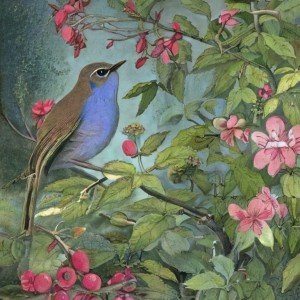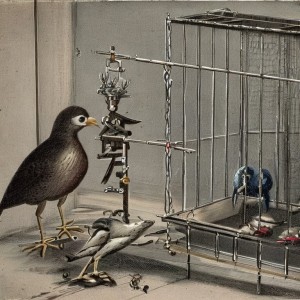History of creation
The tale “The Nightingale” was written in 1843 and published in the collection ” New Fairy Tales”.
Literary direction and genre
“The Nightingale” is Andersen’s literary tale, written in the traditions of romanticism, which is characterized by the image of a creator that is not understood by ordinary people. Such is the nightingale, whose art is so distant from the imperial palace that the courtiers do not even know how his voice sounds. True and mechanical art is contrasted in the fairy tale, which is not art and therefore accessible to everyone (every boy sang a song of an artificial nightingale).
Theme and issues
The theme of the tale is true and false art, the role of a true creator and art in the life of a person and an entire country. An important problem of the tale is the need for free creative expression. The Nightingale warns that his singing is best heard in a green forest, that is, a work of art requires a certain framework. Another important issue is the reward of the creator. The nightingale refuses the emperor’s award – a golden shoe on his neck. For the creator, such a reward is insane, it would become unbearable burden. The reward for the nightingale is the tears of the emperor: “Tears are the most precious reward for the singer’s heart.”
Another question that is important for the romantic trend is whether art should be understood by the people and recognized by them. Both the courtiers and the people are satisfied with the artificial nightingale. The bandmaster assures that the bird is higher than the present even in its internal virtues, because you can explore this art, “make it out”. The people are happy as if they had drunk enough tea, and expressed their understanding of art with an exclamation of “Oh!”
Another problem not directly related to creativity is the problem of life awareness. The emperor lives his life thoughtlessly, as in a dream. Only before death does he realize that true salvation is in living art. All subjects of the emperor, busy with mechanical affairs, simultaneously nodding their heads, also live thoughtlessly. Even death in this tale behaves mechanically, nodding its head thoughtlessly, “like a Chinese.”
The plot and composition
The exposition of the tale is a description of the imperial palace, the garden and its main highlight – the singing nightingale. The palace is described from the point of view of the layman who says that “in the whole world there would have been no better palace than the imperial palace.” The inhabitant sees the value of the palace and garden in man-made unprecedented miracles, the skillful creations of human hands: a palace made of precious porcelain, “so fragile that it was scary to touch it”, wonderful flowers to which silver bells are attached.
Already on display, the artificial is contrasted with the natural, the creation of human hands is against nature. An ordered garden turns into a dense forest, and the forest into a blue sea.
The plot – the emperor’s decision to find a hitherto unknown nightingale – the pride of the country. According to the law of the tale, the courtiers heard the voice of the nightingale the third, after the cow and the frog. Once in the palace, the nightingale receives privileges, each of which means a new degree of unfreedom: a separate room, walking on a schedule and silk ribbons as a leash.
A nightingale, courageously endured captivity and privations that do not interfere with singing, could not only one thing – to sing with an artificial nightingale, because mechanical is incompatible with creative. Each time, the creative person sings in a new way, cannot coincide with the wound barrel organ, with which the artificial nightingale is compared.
The nightingale was expelled from the empire. An artificial nightingale, bathed in glory, sang for exactly a year, and then broke. After repair, it was possible to start it only once a year.
The climax occurs after 5 years, when death comes to the dying emperor. Sitting on his chest, she talks about the good and evil deeds of the emperor. Only the nightingale, who learned about the emperor’s illness, could drive away death.
The emperor is experiencing a rebirth in order to live consciously. The little bird becomes a joy for the kind heart of the emperor, who now wants to know about the life of all his subjects: both poor and rich.
Heroes of a fairy tale
The nightingale is the embodiment of the creator. He is all – naturalness and love of freedom. No wonder he chooses his own home on the border of the two elements, the sea and the forest. The courtiers are struck by the nondescriptness of the nightingale: “The simplest appearance.” The first approximate compares the nightingale’s voice with glass bells (however, the court bonza compares the frog’s voice with bells).
The Nightingale knows about the importance of his art and its healing silt, but does not require awards, except for the tears of those for whom it is intended. The only condition for creativity is freedom.
An artificial nightingale is a gift from the Japanese emperor who, in the Japanese tradition, humiliates himself by affirming the superiority of the Chinese living nightingale over a masterfully made copy. An artificial nightingale has a lot of advantages. He sings one of the melodies of a real nightingale, and according to the method of a court bandmaster, he is much more beautiful than a real nightingale, he is predictable, and therefore convenient, his melody can be learned.
The Chinese emperor, on the one hand, is an image of a ruler who is very far from the people. On the other hand, a collective image of a not too smart, self-employed and considering himself the center of the universe man in the street.
The emperor is a true fairytale ruler. He sits on a golden throne and nods his head (a materialized metaphor of a Chinese boob). The emperor is taken out of emotional balance (as they would say today – from a comfort zone) by the fact that the whole world knows about the nightingale – the main attraction of the Chinese state, and the emperor does not know.
Artistic Originality
The tale is based on a romantic allegory. Andersen takes the action of a fairy tale to an exotic country with strange inhabitants, but a smart reader understands that society in fairy China is the same as in Denmark: there are rich and poor, they treat people of art with the same neglect and do not understand them either.
The bearers of truth in a fairy tale are ordinary people. They are natural, therefore, by nature they know what is good and what is bad. Unlike a layman who appreciates artificial beauty, they believe that the nightingale is good and best.
Like many Andersen’s tales, The Nightingale is intended for both children and adults.
Therefore, common truths intended for children are perceived by adults ironically: “In China, the emperor himself and all his subjects are Chinese.”
Late romanticism is generally characterized by irony and self-irony, which adults like in a fairy tale and are almost inaccessible to children. So the activity of the first approximate is presented as running around the stairs of the palace. All close ones begin to do the same, frightened of punishment. The reward is permission to see how the emperor eats.
Andersen makes fun of the townsfolk imitating a fashionable court nightingale, the ladies gurgling in their throats with water, the shopkeepers who call their voiceless children after the nightingale, the townsfolk talking only about the nightingale. But the most evil ridicule are the means of communication between the ruler and the creator. Obviously, Andersen himself suffered from the “rewards” of power. The nightingale is kept in a castle in prison, which should be taken as care, so the narrator even exclaims: “Great pleasure!” A separate room, a golden pole, twelve servants and each one holds a silk ribbon tied to the paw and permission to walk twice a day and once at night – this is the singer’s court life.
In the tale, Andersen expresses his innermost thoughts about his destiny, sincerely believing that the role of the creator is to influence the emperor, freely telling him the truth about the country and its inhabitants.

